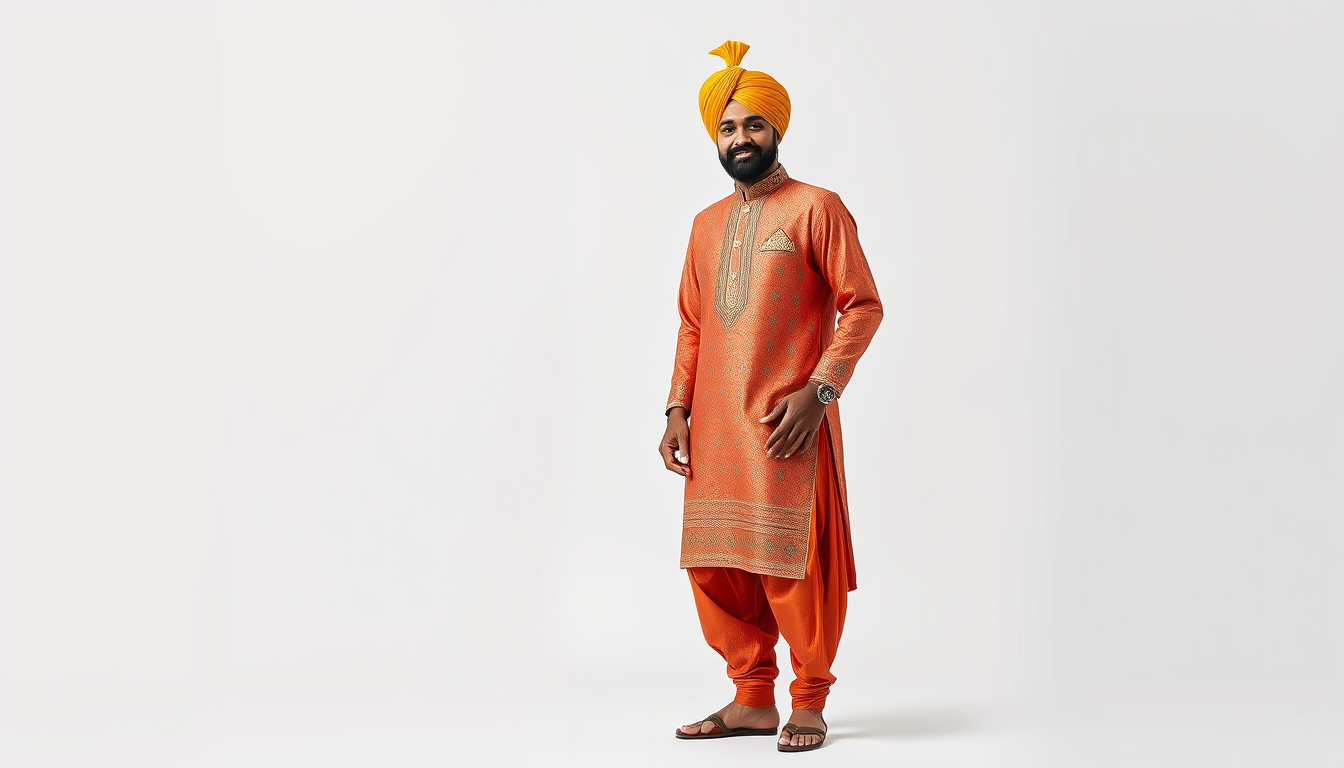Indian traditional men’s clothing is a rich tapestry of history, culture, and craftsmanship. Over the centuries, men’s clothing in India has evolved, reflecting the country’s diverse regions, religious beliefs, and social hierarchies. This article delves into the fascinating world of Indian traditional men’s clothing, exploring its origins, variations, and significance.
The Evolution of Indian Traditional Men’s Clothing
Ancient Times
The earliest evidence of Indian clothing can be traced back to the Indus Valley Civilization, which flourished around 3000 BCE. Archaeological findings suggest that men wore simple garments made from cotton and wool. These early garments included lungis, a type of loincloth, and dhoti, a long piece of cloth wrapped around the waist.
Medieval Period
During the medieval period, Indian clothing became more elaborate. Kings and nobles wore richly embroidered garments, while common people wore simpler clothes. The Mughal Empire, which ruled India from the 16th to the 19th century, had a significant impact on clothing styles. The Mughals introduced new fabrics like silk and brocade, and they popularized the use of intricate embroidery and jewelry.
Colonial Era
The arrival of the British in the 18th century brought significant changes to Indian clothing. The British introduced Western-style clothing, which became popular among the educated elite. However, traditional clothing remained prevalent among the masses.
Regional Variations
North India
In North India, traditional men’s clothing includes the kurta, a long shirt, and the dhoti, a long piece of cloth wrapped around the waist. The kurta is often worn with a sherwani, a long coat, during formal occasions. In the Himalayan region, men wear the gho, a long robe-like garment.
South India
In South India, men wear the dhoti, which is a long piece of cloth wrapped around the waist, and the lungi, a type of loincloth. The dhoti is often worn with a shirt or a kurta. In the coastal regions, men wear the mundu, a long piece of cloth wrapped around the waist and draped over the shoulder.
East India
In East India, men wear the dhoti and the kurta. The dhoti is often worn with a lungi, a type of loincloth, while the kurta is worn with a sherwani during formal occasions. In the tribal regions, men wear traditional clothing made from natural materials like cotton and bamboo.
West India
In West India, men wear the dhoti and the kurta. The dhoti is often worn with a lungi, while the kurta is worn with a sherwani during formal occasions. In the coastal regions, men wear the mundu, a long piece of cloth wrapped around the waist and draped over the shoulder.
Religious Influences
Hindu Men’s Clothing
Hindu men’s clothing varies depending on the region and the specific sect. In North India, men wear the kurta and the dhoti. In South India, men wear the dhoti and the lungi. In the Himalayan region, men wear the gho. During religious ceremonies, men often wear traditional clothing made from natural materials like cotton and silk.
Muslim Men’s Clothing
Muslim men’s clothing in India is heavily influenced by the Mughal Empire. The sherwani, a long coat, is a popular choice among Muslim men. The kurta and the dhoti are also worn, often with a lungi. During religious ceremonies, men wear traditional clothing made from natural materials like cotton and silk.
Sikh Men’s Clothing
Sikh men’s clothing is characterized by the turban, which is a symbol of their faith. The kurta and the dhoti are also worn, often with a lungi. During religious ceremonies, men wear traditional clothing made from natural materials like cotton and silk.
Social Hierarchies
Traditional Indian men’s clothing has always been influenced by social hierarchies. Kings and nobles wore richly embroidered garments made from expensive materials like silk and brocade. Common people wore simpler clothes made from cotton and wool. The use of jewelry and accessories also indicated social status.
Modern Adaptations
While traditional Indian men’s clothing remains popular, it has evolved to meet the demands of modern life. Many men now wear Western-style clothing, but they still incorporate traditional elements into their outfits. For example, a man might wear a kurta with jeans or a dhoti with a t-shirt.
Conclusion
Indian traditional men’s clothing is a rich and diverse tapestry that reflects the country’s history, culture, and social hierarchies. From the simple garments of the Indus Valley Civilization to the elaborate clothing of the Mughal Empire, men’s clothing in India has evolved significantly over the centuries. Today, traditional clothing remains an important part of Indian culture, and it continues to influence modern fashion.
FAQs
What is the difference between a dhoti and a lungi?
A dhoti is a long piece of cloth wrapped around the waist, while a lungi is a type of loincloth that is worn around the waist and falls to the knees.
What is a sherwani?
A sherwani is a long coat that is often worn with a kurta and a dhoti during formal occasions.
How has Western clothing influenced Indian traditional men’s clothing?
Western clothing has influenced Indian traditional men’s clothing by introducing new styles and fabrics. Many men now wear Western-style clothing, but they still incorporate traditional elements into their outfits.
What role does jewelry play in Indian traditional men’s clothing?
Jewelry plays an important role in Indian traditional men’s clothing, as it indicates social status and is often worn during religious ceremonies.
How has technology influenced the production of traditional Indian men’s clothing?
Technology has influenced the production of traditional Indian men’s clothing by introducing new fabrics and techniques. For example, the use of synthetic materials and advanced embroidery machines has made it easier to produce traditional clothing.
References
– “The History of Indian Clothing” by R. S. Khare
– “Indian Textiles and Clothing” by M. K. Srivastava
– “The Mughal Empire: A Cultural History” by Richard M. Eaton
– “The Indus Valley Civilization” by Jonathan Mark Kenoyer
